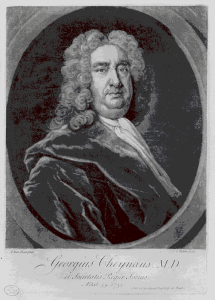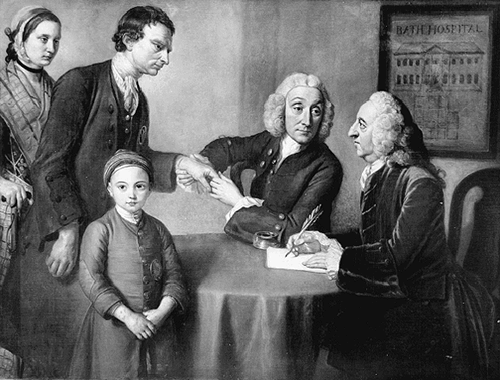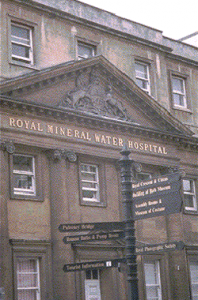Medicine in Bath

- George Cheyne
- [click on the picture to enlarge it]
From the end of the 17th century, Bath’s success encouraged Doctors to settle there permanently. They set up practices near the thermal baths and some boarded patients in their homes. The Doctors were sometimes in competition with the apothecaries, who were allowed to write prescriptions for lower fees. In a book dated 1757, Doctor Baylies mentions the presence in Bath of 17 doctors and 30 apothecaries.
A doctor’s visit was the first step for candidates wishing to undertake hydrotherapy. Plate 1 in the series ‘The Comforts of Bath’ by Thomas Rowlandson shows him undergoing a clinical examination.
Spa water, sprouting from the ground at 43°, was used either for external use, in the form of balneotherapy or showers in one of the four pools : the King’s Bath, the Queen’s Bath, the Cross Bath, the Hot bath; or for internal use, with the absorption of considerable quantities of mineral water at various moments of the day. This treatment took place in the Pump Room, which was extended several times over the course of the 18th century.
Two important names in medicine played an influential role in Bath. George Cheyne, born in Scotland in 1671, was already a celebrity when he set up practice in Bath in 1730. He lived there till his death in 1743. He was specialised in treating gout, the plague of the upper classes. He considered gambling to be a cure.
On the other hand, Doctor William Oliver (1695 - 1764) from Cornwall, spent a large part of his professional life in the famous spa town, where he arrived in 1728. Like George Cheyne, he had an elegant clientele, but he was also doctor to the poor, as he ran activities at the General Hospital (1742) as well.
The General Hospital


- Royal Mineral Water Hospital
- [click on the picture to enlarge it]
The painting by William Hoare for the inauguration of the establishment represents Doctor William Oliver, assisted by the surgeon Jeremiah Pierce, examining patients asking for admission to the Hospital. One of them is a woman leaning on a stick - no doubt she suffers from rheumatism, like the man accompanying her whose hands are deformed. The swollen hands of the child also present are covered in blemishes, probably caused by a skin disease. He is wearing the metal badge which entitles him to free care. These are, no doubt, the most frequent cases dealt with in the establishment, as the publication by Doctor Oliver of the list of infections treated during his service at the hospital emphasizes.
The hospital, still in activity today, which figures in the background, had been built from plans by John Wood. The stone was provided for free by Ralph Allen, while the building was financed by public subscription; Beau Nash worked zealously and tirelessly to collect the necessary funds from rich visitors.

